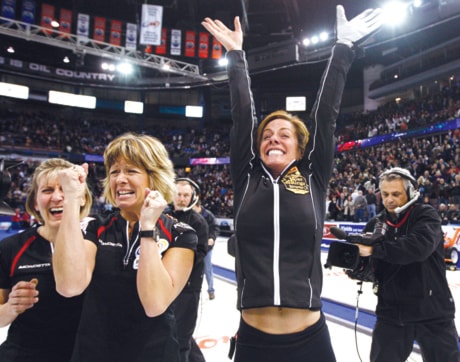EDMONTON — Cheryl Bernard will represent Canadian women’s curling at the Vancouver Olympics.
Bernard knocked off fellow Calgarian and 2006 Olympic bronze medallist Shannon Kleibrink 7-6 to win the Canadian Olympic curling trials and cement her place at the 2010 Games.
The game was tied 6-6 in the tenth end when Bernard went for the winning draw with her final shot. The crowd held its breath until the rock came to a stop at the back of the four-foot for the winning point.
Bernard and her teammates hugged and rejoiced on the ice, before making a bee-line to continue the celebration with their friends and family.
“It’s just amazing. It hasn’t sunk in yet,” Bernard told reporters seconds after the win.
“We lost some finals but we stuck with it and we won the big one finally and I think it’s worth all the pain we’ve gone through in the past four years.”
The win capped off a dominating week for Bernard, lead Cori Bartel, second Carolyn Darbyshire and third Susan O’Connor, who stormed out to a 6-0 start at the trials.
Bernard’s only loss of the tournament came after she had already clinched a spot in the final, and she showed a flair for the dramatic by winning several games in the final end — including one with a five-point double takeout.
O’Connor ran over to the boards and hugged and kissed her husband Todd Brick as the game ended.
“Oh God. Our team has worked so hard and we’re truly a team and it’s nice to win,” she said brushing away the tears.
“I don’t know what else to say. I’m just so happy.”
Bernard, by virtue of her better round-robin record, started the final game against Kleibrink with the hammer.
She inadvertently scored one in the first end — she was trying to blank — when her last rock knocked Kleibrink’s stone out of the house but stayed in the rings.
Bernard increased her lead to 2-0 by stealing one in the second end. She made a masterful draw to the four-foot and forced Kleibrink to attempt a difficult takeout with the hammer, which she missed.
Kleibrink would again miss with the hammer one end later. Attempting a draw for two, Kleibrink threw her stone with far too much weight and had to settle for one.
Her shooting percentage through three ends was just 38 per cent.
Bernard scored one in the fourth end to take a 3-1 lead but could have had more. Kleibrink’s third, Amy Nixon, landed a critical double takeout to minimize the damage.
Kleibrink made a pivotal shot of her own one end later, pumping her fist as her rock snuck through a bevy of others to push Bernard’s off the button. She had to settle for a single point after her final shot ran long.
Bernard continued the string of singles, increasing her lead to 4-2 after six ends with a draw to the four-foot.
Nixon would again come to her team’s rescue in the seventh end by feathering a couple of draws into the eight-foot.
Kleibrink then knocked Bernard’s stone out of the house with the hammer, scoring three and taking her first lead of the night at 5-4.
Bernard regained her lead one end later, scoring two with the hammer. She sent her stone through a narrow opening, knocked out a Kleibrink rock and stuck in the house.
After the shot, Bernard triumphantly held her broom over her head with both hands as the crowd cheered wildly.
Kleibrink looked poised to jump back out in front in the ninth end but with her last stone, Bernard threw a freeze to the eight-foot, forcing Kleibrink to settle for one and tie the score at six.
That set the stage for the tenth end, where Bernard’s draw clinched her rink’s spot at the Vancouver Games.
By winning the trials, Bernard’s rink will receive $180,000 over 30 months from Sport Canada. They’ll also get $50,000 from the Tim Hortons Roar of the Rings host committee and the Canadian Curling Association.
As two of the top four seeds at the trials, both rinks have already received $40,000 each from Own the Podium 2010.
Own The Podium is the $117-million, five-year plan to help Canada win more medals than any other country at its own Games.
